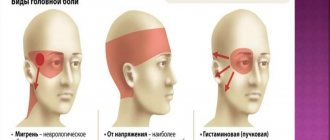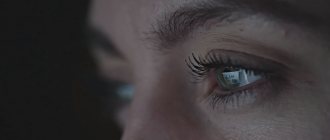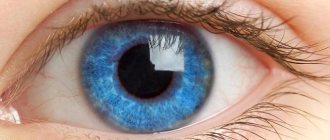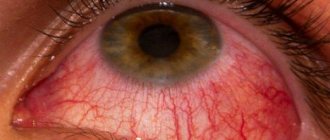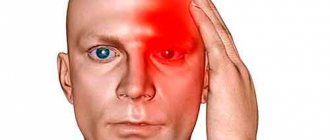Human eyes have a very dense network of nerve endings that are particularly sensitive, as well as pain receptors. Consequently, the eyes are especially sensitive to all processes that occur inside the body and to external influences.
Thanks to the mechanism described above, the human eyes have particularly strong protection, which is expressed in the fact that even with relatively minor impacts on it, severe pain in the eye area can occur.
Oculists determine eye pain even if the pain is not very strong, that is, there are only unpleasant sensations, and if a person has severe severe pain in the eyes. At the same time, the reasons that a person’s eyes hurt badly can be completely different. This is both banal fatigue and more serious reasons - pathological processes in the oculomotor nerve, directly in the eye, in the carotid artery .
Therefore, if the causes of pain in the eyes are not an ordinary eyelash caught under the eyelid, or exposure to a strong wind, you should pay special attention to what is happening so as not to miss the onset of serious diseases.
Causes of pain
Pressing pain in the eyes often indicates the development of angle-closure glaucoma. The pathology occurs as a result of an increase in intraocular pressure due to impaired outflow of moisture from the eye area. With this form of glaucoma, painful sensations radiate to other parts of the head, provoking cephalalgia of moderate intensity in the corresponding half of the skull.
It is worth paying attention to other signs of glaucoma - decreased visual acuity, blurred, unclear images. If at the same time there is a lot of pressure on the eyes and nausea, or there are bouts of vomiting, you should urgently consult a doctor, who, after a diagnostic examination, will tell you what to do. Eyes can hurt due to various reasons:
- Iridocyclitis (inflammation of the iris) in acute form. Accompanied by a feeling of pressure on the eyes. Moderate pain is local in nature and does not spread beyond the visual organs. An additional symptom is increased sensitivity to light stimuli.
- Neuritis (inflammation) of the optic nerve. The disease is accompanied by bursting, pressing pain in the eyes, the causes of which are associated with the inflammatory process provoked by viral or bacterial infections. Painful sensations intensify when moving the eyeballs.
- Conjunctivitis (inflammation of the mucous membrane of the organ of vision). Pathology occurs due to an allergic reaction, bacterial or viral infection.
In what cases should you consult a doctor?
To determine the cause of pain in the eyes, you need to contact an ophthalmologist and accurately describe the symptoms that arise and the duration of their occurrence.
If necessary, the ophthalmologist will refer the patient to highly specialized doctors - a neurologist, traumatologist, therapist, ENT specialist.
Most often, eye pain can be dealt with at home on your own. However, in some situations the patient requires urgent assistance from a specialist. You should consult a doctor as soon as possible if:
- pain does not disappear after taking medications with an analgesic effect and performing various procedures aimed at alleviating the condition;
- pain syndrome torments the patient constantly, regardless of the duration of treatment;
- pressure in the eyes is complemented by severe discomfort;
- pressure and pain in the eyes are combined with temperature fluctuations.
With pain in the eyes, nausea and severe discomfort in any part of the skull, dangerous pathologies can be suspected. Often this sign indicates meningitis, cancer or stroke.
Diagnostic methods
If you have a headache, pressure on your eyes, want to sleep and the condition is accompanied by nausea, urgent medical attention is required. Symptoms may indicate the presence of a serious disease (brain tumor, critical increase in arterial, intracranial or intraocular pressure). Bursting pain in the visual organs with glaucoma may indicate the rapid progression of the disease, which, if untreated, leads to blindness. Basic diagnostic methods:
- Ophthalmoscopy. During the examination of the fundus, indicators of intraocular pressure, the condition of blood vessels, the retina, and the nerve disc are revealed.
- Endoscopy. If the presence of inflammatory processes in the nasopharynx is suspected, an endoscopic examination of the ENT organs is performed.
- CT, MRI. It is carried out if there is a suspicion of the development of pathologies of cerebral vessels, tumors, cystic formations, or foci of intracranial hemorrhage.
If an ophthalmological examination does not reveal any violations of the structure and functions of the visual organs, additional diagnostics are carried out. Consultations with a neurologist, otolaryngologist, cardiologist, and endocrinologist are indicated.
Diagnostic methods for eye pain
Pain may be accompanied by additional symptoms that will help the doctor make the correct diagnosis, and, after reading this article, you will be able to choose a doctor with the required specialization.
Pain and swelling of the eye are typical for:
- phlegmon of the lacrimal sac, which occurs as a complication of long-term untreated inflammation of the eyelid. Described in the section “If not only your eyes, but also your head hurt”;
- phlegmon of the orbit (described in the section “When the eyelids hurt”);
- abscess or phlegmon of the eyelid (look in the section “When your eyelids hurt”);
- boil of the century;
- herpetic lesions of the eyelid and other pathologies described in the section “When the eyelids hurt”;
- scleritis;
- sclerokeratitis;
- barley;
- blepharitis (inflammation of the eyelids);
- if swelling and pain appeared after sleeping in an uncomfortable position or bending over, when the level of the eye sockets was below the level of the heart, this means that the vessels responsible for the outflow of blood from the underlying areas have become weaker.
Eye pain and nausea develop with:
- acute attack of glaucoma;
- hypertensive crisis;
- migraine;
- meningitis;
- stroke;
- brain tumors;
- encephalitis;
- endophthalmitis;
- phlegmon of any area in the orbital area.
When eye pain and spots appear, it may be:
- cervical osteochondrosis;
- posterior uveitis: then vision seems to be blurred, with dots “floating” in front of the eyes;
- arterial hypertension;
- destruction of the vitreous body;
- retinal disinsertion;
- cardiopsychoneurosis;
- anemia – reduced amount of hemoglobin;
- vitamin deficiency or hypovitaminosis;
- intraocular tumor, which manifests itself not only as pain, but also as a decrease in visual acuity and a change in the color of the iris;
- migraine with aura;
- retinal damage in diabetes mellitus;
- aura with Morgania-Adams-Stokes syndrome (short-term attacks of cardiac arrest);
- decreased blood pressure due to sudden standing up. This is enhanced by drugs that lower blood pressure, antidepressants, and diuretics.
Pain in the eyes when moving the eyes is typical for:
- phlegmon of the orbit. In this case, the eyelids are swollen, the eye is bulging, and symptoms of general intoxication are observed;
- optic neuritis;
- orbital cellulite;
- high body temperature;
- herpes zoster;
- eyeball injuries;
- inflammation of the oculomotor muscles (myositis).
If pain develops when you cry, this indicates a possible focal violation of the integrity of the cornea (for example, erosion). If the syndrome is characterized by a dull, bursting nature, and intensifies when moving the eyeballs, this may mean that the person has increased intraocular pressure.
First of all, the specialist will conduct a visual examination of the organs of vision and assess the condition of the cornea, eye socket and eyelids. The following diagnostic methods may also be prescribed:
- study of peripheral vision to establish the boundaries of the visual field;
- examination of the fundus of the eye using an ophthalmoscope. This method will allow us to study the retina, optic nerve disc, and blood vessels;
- biomicroscopy. Examination of ocular tissues with a slit lamp. Helps identify glaucoma, keratitis, iridocyclitis and other inflammatory phenomena in blood vessels;
- tonometry is used to measure pressure in the organs of vision;
- Ultrasound is used to assess the structure of the eye, the condition of the lens and retina;
- pathologies of the cornea can be detected using confocal microscopy;
- A fluorescein test will allow you to assess the condition of the lacrimal ducts, as well as detect dacryocystitis.
It is necessary to find out why there is pressure on the eyes from an ophthalmologist. Using a special device, intraocular pressure is measured and the result is evaluated. In addition, an ophthalmological examination is carried out aimed at studying the condition of the optic nerve.
To confirm the diagnosis, the following types of studies may be prescribed:
- MRI. Using this procedure, it is possible to determine which pathologies caused the unpleasant symptom. MRI helps identify strokes, cystic formations, tumors and hydrocephalus.
- Ultrasound. This diagnostic method determines the presence or absence of vascular damage, thrombosis and the speed of blood flow.
- CT. The procedure determines the presence of an inflammatory process affecting the bone structure of the head. In addition, CT scans can detect the presence of pathologies such as sinusitis and frontal sinusitis.
If indications are present, the ophthalmologist may refer the patient for consultation to other specialists.
Treatment methods
Treatment of conditions where the eyes hurt, as if there is pressure on them, is carried out taking into account the causes of the symptoms. Therapy is aimed at eliminating the primary disease that led to disorders and the appearance of symptoms.
If your head is heavy, you want to sleep and there is pressure on your eyes without obvious signs of illness, the condition may be associated with physical or nervous fatigue. In this case, in order to restore vigor and efficiency, a full, restful sleep is recommended.
Drug therapy
If the feeling of pressure on the eyes is associated with an increase in blood pressure, it is necessary to take a vasodilator drug (Farmadipine, Captopril, Nifedipine) as prescribed by the doctor. There are two types of eye drops - with a therapeutic effect and those that alleviate the condition of fatigue or irritation.
In the first case, the drugs have an anti-inflammatory, antispasmodic, vasodilator, antihistamine, restorative effect, in the second - they moisturize the mucous membrane, eliminate soreness and redness. Drops with a pronounced therapeutic effect are prescribed by an ophthalmologist, taking into account the causes of symptoms.
Self-medication in this case can aggravate the situation and cause irreparable harm to health. Drops that eliminate the symptoms of “dry eye” are indicated for people who, due to their job duties, spend a lot of time at the computer. Moisturizers and vitamins (Maxima Revital Drops, Avizor Moisture Drops, Biotrue Drops) for the eyes have the following effect:
- Soothe and eliminate irritation.
- Reduce the feeling of dryness and discomfort.
- Relieves redness.
- Nourish and saturate tissue with vitamins.
Moisturizing eye drops envelop the mucous membrane, protecting it from drying out and damage. Many such drugs are analogues of the natural secretion of the lacrimal glands.
Folk remedies
If you regularly feel pressure in your left or right eye, traditional healers recommend using compresses based on medicinal plants with anti-inflammatory, decongestant, and soothing effects. Typically, decoctions made from oak bark, chamomile flowers, and strong black tea are used for compresses.
Eye exercises
The inability to focus the gaze on an object, increased sensitivity to light stimuli are harbingers of visual dysfunction caused by long periods of time at the computer. The main reasons why it feels like the eyes are being squeezed out from the inside:
- Overstrain of the focusing muscle of the lens.
- Constant strain on the visual organs due to the close location of the monitor, prolonged perception of a two-dimensional image instead of the usual three-dimensional picture.
- Drying of the mucous membrane due to concentration of attention on an object and a reduction in the number of physiological blinks.
The first exercises for eye training were developed within the framework of eastern practice - yoga. Special gymnastics designed for the visual organs helps relax the eye muscles, eliminates signs of fatigue, improves visual function, and serves as a prevention of ophthalmological diseases. If there is pressure on your eyes after a long stay in front of a monitor screen, exercises will help get rid of the unpleasant sensations:
- Cover your organs of vision with your palms without pressing, close your eyelids, and remain in this position for 30-60 seconds.
- Blink frequently continuously for 15 seconds.
- Move your eyeballs (while keeping your head still) - right and left, then up and down. The number of movements in each direction is at least 10. After performing the exercise with your eyes open, do the same with your eyelids closed.
- Draw circles, draw a figure eight sign with your eyeballs (keeping your head still) alternately in both directions. Do the exercise first with your eyes open, then with your eyelids lowered.
- Move the eyeballs to the bridge of the nose at the same time. Holding your gaze in this position for a few seconds, return the eyeballs to their original position.
- Draw letters of the alphabet or any other symbols with your nose. Exercise helps relax the neck muscles, which is associated with improved blood supply to the head, including the organs of vision.
While performing the complex, maintain even, calm breathing. If conditions permit, you can do gymnastics to relaxing, pleasant music. Psychological attitudes aimed at rest and relaxation of the body help relax the eye muscles.
Treatment
Treatment methods depend on the causes of pain in the eyeballs:
- infectious pathologies of bacterial etiology require oral antibiotics (Amoxicillin, etc.), as well as instillation of antimicrobial drops (Levomycetin, Tobrex, Floxal);
- If the pain is of viral origin, antiviral ointments (Acyclovir) are used. You will also need to use local antiseptics (Ocomistin), anti-inflammatory and hormonal drops;
- if the disease is allergic, antihistamines are used internally (Tavegil) and topically (Allergodil drops). In some cases, glucocorticoids (Dexamethasone) are used;
- intense pain symptoms can be relieved with painkillers (Analgin, Ibuprofen), antispasmodics (No-shpa, Spazmalgon), which will remove muscle spasms and improve the functioning of the eyes;
- if it hurts to rotate apples due to injuries and damage, the doctor may prescribe pain-relieving drops (Inocaine, Diclofenac), regenerating ointments (Solcoseryl), anti-inflammatory drugs (Sofradex, Vial);
- Systane, Visin, Oxial drops will help relieve fatigue from the eyes and moisturize the mucous membrane;
- You can enrich the tissues of the visual organs with vitamins and improve nutrition with the help of vitamin preparations (Complivit ophthalmo);
- for intense irritation, Korneregel is prescribed;
- Irifrin drops will help protect against dryness and reduce pressure in the eyes;
- Emoxipin and Systane Ultra are used to relieve dry eye syndrome;
- Visoptik will help protect the visual apparatus from irritation when wearing contact lenses;
- more serious diseases, such as cataracts and glaucoma, require implantation of an artificial lens;
- If contact lenses are incorrectly selected, they need to be replaced;
- to relieve overstrain after prolonged work, eye gymnastics and palming are used;
- If the pain in the eyeballs is not associated with severe pathologies, folk remedies can help. You can reduce inflammation and swelling with tea compresses, chamomile or calendula lotions.
The choice of remedy for eye pain depends on the cause. For example, when intracranial pressure increases, diuretic therapy (Diacarb, Mannitol) is used, sometimes surgical treatment, sometimes antibiotics. If the cause is a pathology of the thyroid gland, either suppression of its hyperfunction or the addition of those hormones in which there is a deficiency is prescribed.
Taking into account the considered diseases, the causes most often appear in eye diseases. What you can do before seeing a doctor in this case:
- take a painkiller tablet (Ibuprofen, Nise, Analgin);
- if the eyeball is extremely hard to the touch, take a diuretic tablet (Furosemide, Lasix);
- drip the eye with an antiseptic or antibiotic: “Ciprofloxacin”, “Oftamirin”, “Levomycetin drops”.
If help is provided for eye injuries, before visiting a doctor, you need to rinse it with running water and drip it with an antiseptic. When an acid or alkali gets into your eye, read the instructions for the substance that got into your eye: it should indicate what to do in this case. If such information is not available, an ambulance is needed, before which the eye cannot be washed out due to the danger of the formation of toxic substances on the surface of the cornea with subsequent ulceration.
For foreign bodies or thermal burns, rinsing with running water should be a mandatory step before visiting the 24-hour Eye Trauma Department.
Even if first aid was provided in a timely and correct manner, this does not cancel a trip to the ophthalmologist in response to the onset of illness. Sometimes urgency of action can save, if not life, then vision.
Preventive actions
To prevent a condition where there is pressure on the eyes, pain and dizziness, you need to avoid overworking the visual organs. Ophthalmologists recommend adhering to the following rules:
- Take a break after every 30-60 minutes of working on a computer device. During the rest period, you need to distract yourself, look away from the monitor, and do several special exercises to relax your visual organs. The duration of the break is 10-20 minutes.
- Massage the eye orbits regularly. Covering the eyelids, apply light pressure movements with the fingertips to the orbital area. Make 10 gentle, effortless pressures on the visual area.
- Sit with your eyes closed for 5-10 minutes.
- Using the tips of your little fingers, lightly press on the area of the inner corners of the organs of vision. The effect stimulates tear production, due to which the mucous membrane is moistened, the feeling of burning and the presence of foreign objects (sand) disappears.
How to deal with the problem
After determining the cause of this condition, when there is pressure from inside the eye, a specific treatment is selected.
Drugs
https://www.youtube.com/watch?v=
Drug therapy includes taking painkillers such as Analgin and Pentalgin. The condition can be alleviated with the help of non-steroidal drugs with an anti-inflammatory effect, among which Diclofenac and Ibuprofen are considered the most effective. To improve the removal of fluid from the body, it is possible to prescribe drugs such as Furosemide and Diacarb.
Patients whose cause of pain in the eyes is a bacterial infection are prescribed antibacterial drugs. To treat the eyes, it is recommended to use Erythromycin ointment, and oral medications in tablets, for example, Cephalexin and Amoxicillin.
When pain in the eyes occurs as a result of stress or nervous tension, various antidepressants, tranquilizers and sedatives can be prescribed. For increased intraocular pressure, drops such as Azopt, Travatn, Bitoptik and Pilocarpine are usually prescribed.
Exercise for the eyes
You can relieve pain caused by fatigue with the following exercises:
- you need to look left and right, up and down;
- move your eyeballs clockwise and back;
- draw a square in the air clockwise and back;
- Draw several figure eights in the air in a horizontal and vertical position.
You need to do the exercises up to 10 times during the day, adhering to the specified sequence.
Non-traditional treatment methods help alleviate the patient's condition, but they are unable to completely cure the disease. At home, it is recommended to wash your eyes with chamomile or aloe decoctions. To do this, moisten a cotton pad in the prepared liquid and wipe your eyes with it so that the product is slightly squeezed onto the mucous membrane.
It is allowed to take decoctions of mint or lemon balm, which will relieve unpleasant sensations inside the organ of vision. Clover infusion helps to cope with discomfort due to pressure surges inside the eye.
Dangerous conditions
Glaucoma attack
A large volume of formation of intraocular fluid or its difficult outflow causes an increase in pressure in the anterior chamber of the eye. Intraocular fluid puts pressure on the eyes from the inside. In this case, damage to the optic nerve head and retinal vessels occurs, which causes symptoms characteristic of an attack of glaucoma:
- the appearance of a halo around light sources;
- reduction of visual fields (so-called peripheral scotoma);
- deterioration of vision at dusk;
- impaired color perception;
- decreased vision;
- the eye hurts from the inside, there is a feeling of a foreign body in it.
As you can see, the symptoms are not specific, so if you suspect an increase in intraocular pressure, you should definitely contact an ophthalmologist for additional examination - tonometry (measurement of eye pressure) and gonioscopy (examination of the anterior chamber of the eye).
Papilloedema
Simply put, this is swelling of the optic nerve head - where it attaches to the eyeball. Swelling of the optic nerve nipple creates a protrusion into the eyeball and puts pressure on the eye from the inside.
The cause of papilloedema is an increase in intracranial pressure. But only if the symptoms of optic disc edema and increased intracranial pressure are observed simultaneously, we speak of papilloedema.
This occurs as a consequence of inflammation of the brain or its membranes, hemorrhage in the skull, or tumor processes.
Swelling may develop over several hours or weeks. When sneezing and coughing, the condition usually worsens, the pain intensifies, vision is blurred, the image is double, and headaches intensify. Lying on your back usually brings little relief.
This condition requires immediate medical attention and treatment of the underlying disease.
Optic neuritis
The symptoms of inflammation of the optic nerve are similar to papilloedema, but there is no increase in intracranial pressure. According to the observations of experts, most often this disease is associated with demyelination of nerve fibers, which occurs in multiple sclerosis.
In this case, the eye hurts from the inside in the orbital area, especially when moving. Color vision is impaired, overall visual acuity is reduced, and manifestations of photopsia may be observed - luminous dots or lightning on the retina.
Headache
It happens that the inside of the eye hurts due to a headache.
Particularly acute pain occurs with the cluster type of pain, when attacks follow one after another, and then disappear for several months or even years. In this case, only one half of the head is affected. The right eye hurts or the left eye hurts from the inside so much, as if it had been “pierced with a hot knitting needle.” Cluster headaches are triggered by the sudden release of histamine or serotonin and their effect on nerve fibers. Other symptoms include redness, swelling of the cornea, watery eyes, nasal congestion and rhinitis.
The headache can also be a type of migraine. At the same time, it presses the eye from the inside with a special pulsating wave, which is very intense and painful. Seizures can begin suddenly in response to certain smells, flickering lights, noises, sunlight, food, etc. Each person suffering from this disease has their own personal “triggers”.
Another reason why there is pressure in the eyes is high blood pressure. In this case, discomfort in the organs of vision is created by increasing blood pressure in the central ophthalmic artery and obstructing the outflow of venous blood from the central retinal vein. When you press on the eyeball, you feel increased elasticity and pain from the touch. Often, high blood pressure is accompanied by headache and dizziness, and a person sees “spots.”
Why does it put pressure on the eye?
In a situation where the eyes hurt as if they were pressing, it is necessary to study the regularity of this manifestation and the circumstances of its occurrence. For isolated attacks in people working at a computer or with papers, there is no need to worry too much. It is necessary to contact a specialist if the patient develops additional symptoms. A condition when there is constant pressure on the eyes is considered a dangerous signal, so this most often indicates various diseases.
Migraine
With a pathology such as migraine, pain localizes to one side of the head. In addition, there is a pulsation in the temple, which spreads to the ear and organs of vision. If your eyes are closed, colored circles are formed, which are complemented by flashes. In addition, there is pronounced pulsation in the eyelid area.
Overwork
Working at a computer for too long and reading small print texts increases the likelihood of eye discomfort. In addition, the cause of severe pain can be any activity that requires increased attention and strong visual strain.
With severe overwork, a person suffers from pain in the organ of vision, a sensation of cutting and burning. It feels as if sand has been poured into the eyes, and there is a disturbing feeling of pressure and heaviness.
Glaucoma
A pathology such as glaucoma, caused by an increase in pressure inside the organ of vision, does not always provoke pain. Usually there is a dull or aching pain, which is complemented by various visual changes. Fogging of the cornea, the appearance of rainbow circles and photophobia are observed.
During an acute attack of glaucoma, the patient experiences sudden pain in the organ of vision, which radiates to the temples, the back of the head and sometimes along the trigeminal nerve. Attacks of nausea and dizziness, as well as significant changes in the eyes, may occur. When examining the patient's face, it becomes noticeable that the cornea and eyelids swell greatly, and the pupil dilates significantly.
Increase in pressure
The situation with pain from inside the eyes may indicate surges in intracranial pressure. The cause of the pathological condition lies in a concussion, stroke and impaired outflow of cerebrospinal fluid. In addition, a rapid increase in the size of a cyst or malignant neoplasm localized in the skull can cause pain.
The patient complains not only of pressure, but also of increasing pain, pain and pulsation behind the organ of vision. When coughing, blowing your nose and other sudden movements, an even greater increase in pain is noted. In addition, symptoms such as nausea, spots before the eyes, hallucinations and increased drowsiness may appear.
In some cases, pressure from inside the eyelids and the appearance of a feeling of fullness inside the organ of vision indicate surges in intraocular pressure. The patient experiences severe redness of the sclera and a feeling of heaviness in the eyelids.
If the increase in pressure inside the eyes is chronic, then there is a high probability of degeneration of the optic nerve and the appearance of glaucoma. With this pathological condition, the patient experiences a gradual narrowing of the field of vision and, in the worst case scenario, the patient may become completely blind.
Other reasons
Experts identify some reasons that cause increased pressure in the eye and pain:
- Increased psycho-emotional stress. In this condition, any increased stress can cause severe pain in the forehead and eyes.
- Osteochondrosis of the neck. The cause of damage to the organ of vision is frequent headaches and curvature of the spine.
- Various visual impairments. Various infections inside the organ of vision, inflammatory processes, barley and injuries to the corneal layer of the eye can provoke an unpleasant symptom.
- Problems with blood supply to the brain. This condition causes headaches, which can result in a stroke.
- Injuries and damage to the skull. Pressure in the eye in this pathological condition can be accompanied by weakness, nausea, double vision, and a constant desire to sleep.
- Changes in hormone levels in the female body. Most often, expectant mothers experience a feeling of pressure in the eye during pregnancy.
Pain as a secondary symptom
Often, in search of the reason why the eye hurts, we do not pay attention to the structures surrounding it. But inflammation or disease can occur in a completely different organ.
For example, with sinusitis or frontal sinusitis, when the paranasal or frontal sinuses become inflamed, pressing pain may be felt in the eyeball. It is created by swelling of the mucous sinuses, which are anatomically very close to the eye sockets.
Sometimes if your eye hurts, you should pay attention to... your teeth. The fact is that the structures of the facial skull are innervated by various branches of one trigeminal nerve.
The upper branch is responsible for the eyes, the middle branch is responsible for the upper jaw, cheeks and lips, the lower branch is responsible for the lower ones. With dental infections, gumboil, and deep caries, inflammation of one of the branches of the trigeminal nerve may occur, which will have a painful effect on all innervated organs.
In addition, any systemic infectious disease accompanied by fever and symptoms of intoxication usually causes pain inside the eyes.
Why does the inside of the eye hurt?
Note! Painful sensations from inside the eye in the absence of obvious external signs can occur for the following reasons:
- Excess blood in the vascular system of the eye , resulting from conjunctivitis. In such cases, cutting pain appears, accompanied by itching and burning.
- Inflammation of the tissues of the eye , provoked by infectious lesions of the nasal sinuses.
- Chronic eye fatigue when constantly working at a computer. The pain in such cases may become dull during work and worsen at night.
- Incorrectly selected optical vision correction devices, when worn, refraction is impaired.
- Injuries and foreign objects getting into the eyes.
- Migraine.
- Inflammation of the cranial nerves , in which, despite severe pain in the tissues of the eyeball, no pathological changes are observed.
- Pinched nerve endings in the neck caused by osteochondrosis.
Also, intraocular pain can be triggered by ophthalmological diseases: glaucoma, uveitis, iritis , cataracts or a disorder such as astigmatism (in the latter case, pain can appear in only one of the organs of vision).
Ophthalmic causes
Infectious
While the diseases listed above are difficult to see, most problems affecting the eyes themselves can be recognized visually.
When the inner corner of the eye hurts, you should carefully examine this area; you may find inflammation, redness, pus, and swelling. There may be several reasons.
Young children most often suffer from partial or complete obstruction of the lacrimal ducts or inflammation of the lacrimal sac (dacryocystitis). The child does not have a physiological opening of the tubules immediately after birth, which creates conditions for the accumulation and growth of bacteria.
In adults, this condition provokes swelling of the nasal mucosa, which blocks the outflow from the lacrimal sac. When a bacterial infection occurs, pus forms and can be seen in the corners of the eyes.
How to behave correctly
What to do if your eye hurts?
First of all, inspect it for damage, hemorrhages, and foreign bodies. If you notice an injury, seek medical attention. If there is no visible damage, you can rinse your vision with special solutions (such as artificial tears) or clean water.
If you have chronic diseases, for example, arterial hypertension, measure your blood pressure; you may need to take your usual medications to lower it. The same applies to attacks of glaucoma and migraines.
If there are signs of conjunctivitis or another infectious disease, you need to use drops with an antibacterial or antiviral effect.
If you have ARVI or another disease accompanied by fever, then you can relieve discomfort (including in the eyes) by taking non-steroidal anti-inflammatory drugs - paracetamol, ibuprofen.
In any case, if the pain is intense, accompanied by blurred vision, or remains for a long time, you should visit a doctor to rule out a serious pathology and receive recommendations for treatment.
Doctors associate involuntary contraction of the eye muscles with disorders of the nervous system. But the people have their own opinion on this matter, which is expressed in signs. Let's figure out why the eye twitches and what secret meanings this physiological feature has.
Attention! The material is for informational purposes only. You should not resort to the treatment methods described herein without first consulting your doctor.
Subjective reasons
This is how you can characterize the sensations when there is nothing on the cornea or eyelids, but the feeling of a foreign body is present.
This is the case when a vessel bursts in the eye and microhemorrhage forms. This often occurs when overwork, increased intracranial or blood pressure, or being in a head-down position.
For some people, increased intraocular pressure due to glaucoma may be perceived as the presence of something foreign in the eye.
Also causing discomfort is “dry eye syndrome,” in which the dry cornea reacts especially sensitively to any touch.
Some nervous or psychosomatic diseases can give rise to unjustified sensations of a foreign body in the eyes and a desire to constantly rub them.
Why is the right eye twitching?
Many of us are aware of various superstitions that are associated with seemingly ordinary incidents: spilled salt, a black cat crossing the road, a broken mirror, etc. In such things, people, as a rule, see a special omen.
No matter how skeptics and rationalists modern people are, they still have to agree that some signs have real confirmation by facts and events, especially when you believe in them.
Why do you dream about church: interpretation according to different dream books
Photo: ask-why.ru: UGC
Eyes are one of the objects with which a whole complex of signs is associated.
The people believed that eyes reflect the soul and true thoughts of a person. The look of a bad person can harm a child or a person weak in spirit and body; In ancient times, green-eyed women were considered witches. And to this day, if an eyelash falls out, many people ask you to make a wish.
Do you know what happens if your eye suddenly twitches? If you believe in omens, then take the information presented and check if the people are right.
So, what events should you expect if your right eye twitches:
- Such a sudden tic in a man means that on this day you will make a big profit, make a profitable deal, and become the owner of a large sum of money.
- Women should pay special attention to this phenomenon. For them, twitching of the right eye is a warning that something bad or trouble is approaching. For young girls, this is a sign that they will have to bitterly regret and cry about something.
- If your eye twitches on Monday, Friday or Saturday, you should be careful and attentive. On other days, such a physiological feature reports a joyful event.
Why do dead people dream: interpretation according to different dream books
Different peoples decipher this sign of fate differently. Thus, the Turks and Greeks see misfortune and tears in this harbinger, while the Chinese, on the contrary, expect changes for the better, unexpected luck and resolution of controversial issues.
Regardless of what events the twitching of the right eye promises, read a prayer or visit a temple, tune in to the positive.
In this way, you will neutralize the omen if it portends trouble, or, conversely, you will gain supporters among good spirits, because it is known that the right side of a person is the side of the guardian angel. Through parts of the body located on this side, he gives certain signs to the individual.



